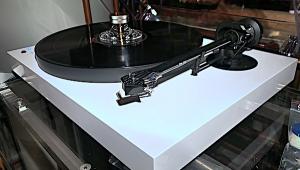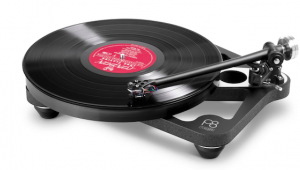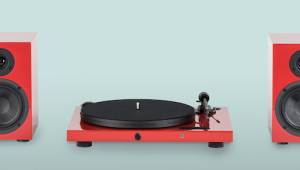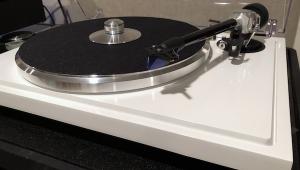Not many would be disappointed by either TT setup. I think the built in phono stage is a little warmer, but that is not a bad thing. $399 in today's dollars is a huge bargain.
Pro-Ject T1 Phono SB Turntable—Born of Frustration
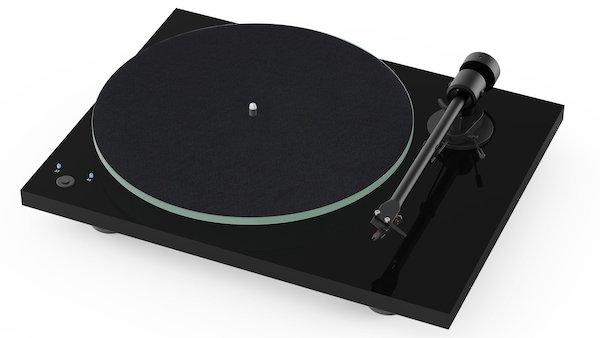
“These cheap plastic turntables from China are hurting my business….” he began. His biggest concern was not the small bottom line incursion into his expansive product line that’s grown to include digital and tube electronics, amplifiers and speakers, but rather that people buying cheap plastic “starter” turntables would have a bad vinyl experience.
Cynics might think his primary concern was the bottom line, but they don’t know Heinz. Though at the time he feared he’d not be able to compete in that market segment with a product worthy of the Pro-Ject name, he’s come up with the T1—a physically attractive, high performance, well-constructed turntable that’s competitively priced and built to “no plastic” higher construction standards.
The T1 is available in 3 editions: the standard “no frills” model ($329), the T1 Phono SB that adds an electronically regulated precision-speed A.C. motor with push button 33 1/3/45rpm speed selection and a built-in switchable MM phono preamplifier ($399) and the T1 BT that adds Bluetooth streaming ($449). The review here is of the T1 Phono SB, though the less costly T1 is very similar and also includes an Ortofon OM5e cartridge that tracks at 1.75 grams.
As Mr. Lichtenegger promised, you won’t find plastic here. The CNC machined MDF plinth has no hollow spaces inside and the high-gloss black exterior’s finish (also available in gloss white and walnut) is uncommonly well-finished for a turntable at this price point. It sits on vibration absorbing feet.
More importantly, the drive system includes a machined aluminum pulley, a precision flat belt, plus a newly designed sub-platter mounted into an ultra-precise 0.001mm main bearing with a hardened steel axle and brass bushing as found in the Essential III turntables. The platter is a new full-sized blasted-glass design.
Pro-Ject designed a new one piece 8.6” aluminum tonearm for the T1 riding on precision bearings with an effective 218.5mm length and 8 gram effective mass. It can accommodate cartridges weighing between 5-10 grams. Tracking force range is between 0 and 5 grams. There’s a built-in anti-skating compensation of some sort I was told and no adjustments for azimuth or VTA/SRA, which is fine for this price point where rigidity is more important the adjustability.
Accessories include a hinged dustcover, felt mat, overhang and tracking force gauges a 45rpm adapter and a set of “Direct soldered” low capacitance Connect it E phono cables.
Holy Crap! Look at These Speed Measurements!
You don’t expect great speed consistency or accuracy at this price point, but you expect reasonably good, right? I couldn’t believe what I saw when I looked at the Platterspeed app’s report:
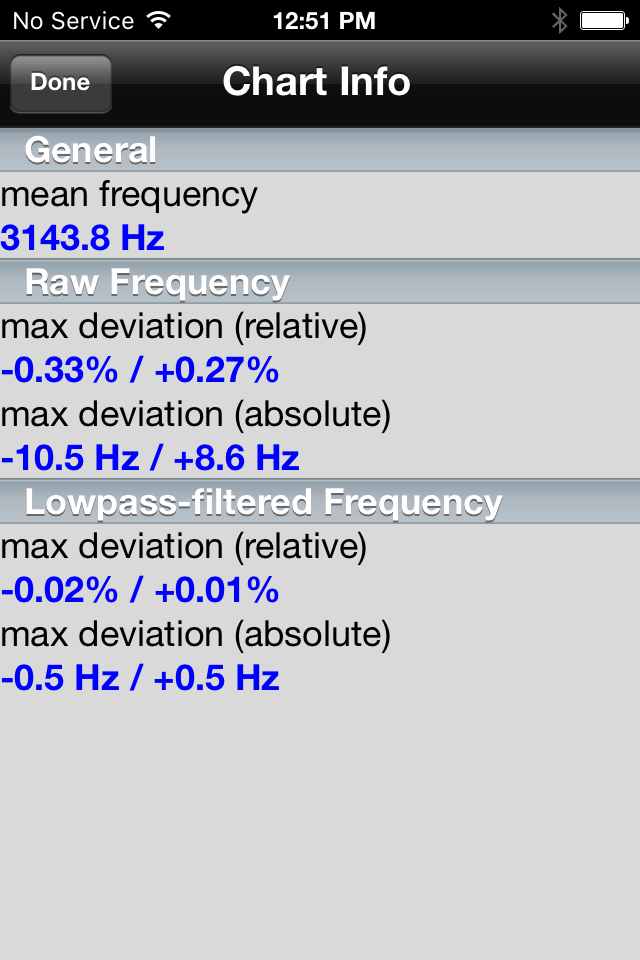
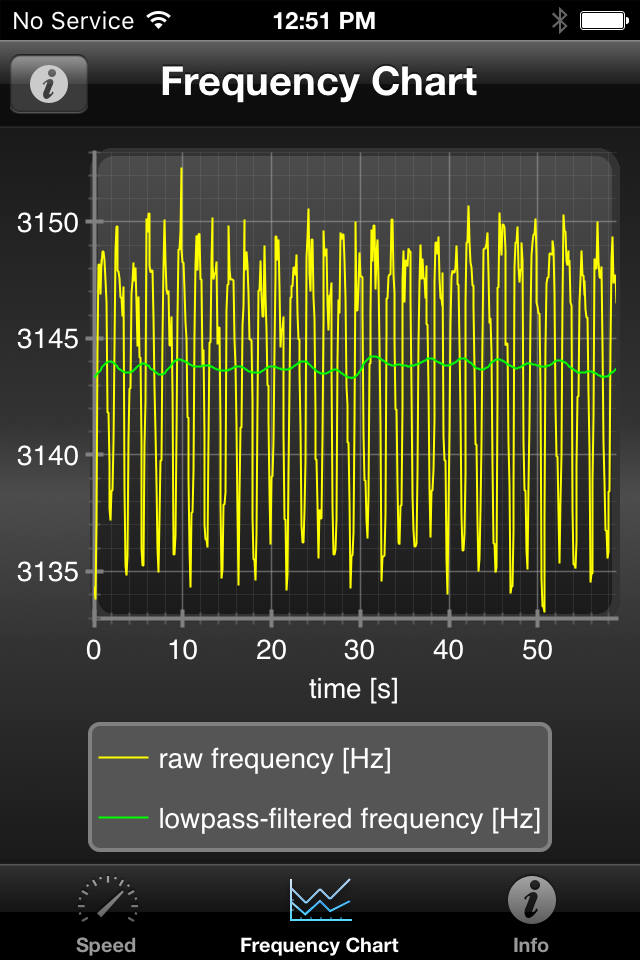
You see measured speed consistency performance from few if any $399 turntables. Yes, it runs slightly slow but only slightly and the low pass filtered relative and absolute deviations are eye popping to the point where I had to repeat them before believing.
Set-up and Use
The T1 sets up easily. The cartridge is pre-installed and tracking force pre-set. I checked out the overhang and tracking force and both were correctly set—something you can’t take for granted. The feet can’t be leveled so make sure your platform is.
The T1 is out of the box and playing records in a matter of minutes, making it a great first turntable choice. A somewhat hidden switch mounted on the RCA jack junction box switches between the built-in phono preamp (“line-out”) and direct out of the arm to connect to an outboard phono preamp. It comes set for the built-in phono preamp. Speed change at the push of a button is a great convenience.
Warm, But Well-Controlled And Quiet Backgrounds
One of the first records I played was My Point of View (Blue Note BST 84126/B0031882-10) a new and highly recommended “Tone Poet” reissue. It was Herbie Hancock’s second outing and features an incredible lineup: Donald Byrd, Grachan Moncur III, Grant Green, Hank Mobley, Chuck Israels and Tony Williams. No kidding! It’s worth getting if just for “A Tribute to Someone” a gorgeous ballad highlighted by Donald Byrd. The opening track “Blind Man, Blind Man” (which today would have to be re-titled “Vision Impaired Man, Vision-Impaired Man” is a funky complex number Herbie says in the notes is in the same genre as “Watermelon Man” not that you’d have to be told that to get it, but it’s got a lot of doubling going on and I was pleased to hear how well this set-up revealed it—especially where Green and Hancock are in lockstep. The bottom end was well-controlled and the designer or whoever “tuned” the system wasn’t shy about letting the bottom end express itself without worrying about a loss of transient bass control, even though the plinth was somewhat “lively to the tap” (but not nearly as “live” as some others at this price point and higher).
The overall timbral balance was super-satisfying if slightly on the warm side but not too much so. Mobley’s horn on “A Tribute to Someone” came right out and fully expressed itself on the right channel, while Byrd on the left floated nicely free of the speakers. Seriously, you’d never know you were listening to a $399 turntable—at least until you played the same record on one costing a great deal more. No sonic apologies necessary from this well designed budget ‘table.
I’m not sure if anything else at $399 performs this well, which is a tribute to both it, the quality of the Ortofon OM5e and the competently designed built-in phono preamp. I didn’t try it but no doubt if you buy this turntable, when the stylus needs replacing you can upgrade to far costlier, higher performance MM cartridge and seriously up the already fine performance.
Why not have a listen for yourself? Here are two excerpts from a new Yarlung Records two part 45 rpm release, Yuko Mabuchi Plays Miles Davis Volume 2 (Yarlung Yar 45591-171V). This live recording recorded to tape in 2018 at the uniquely named Brain and Creativity Institute’s Cammilleri Hall features the talented pianist Yuko Mabuchi backed by JJ Kirkpatrick on trumpet, Del Atkins on bass and Bobby Breton on drums. AKG C24 and C12 plus Schoeps M222 vacuum tube microphones captured the quartet. Bernie Grundman cut lacquers directly off the tape recorder—no board in between.
Clearly Mr. Kirkpatrick is in the most difficult position here: it’s a pianist’s tribute to Miles. She’s the star so what’s he to do? I think he plays it just right, nicely laying back. The recording does likewise, producing notable front to back depth. One version here uses the T1’s built-in phono preamp. The other uses a new $149 iFi Zen MM/MC phono preamplifier. Hear which you prefer (this is not a blind ‘test’):
Conclusion
Everything about this low cost, full featured Pro-Ject turntable impressed: the design, construction, feature set, measured performance and of course the sound. Plus, it really looks great! Made in the Czech Republic. No plastic parts. Easy recommendation.
Specs:
Speed: 33, 45 (electronic speed change)
Principle: Belt drive
Speed variance:
33: 0.7%
45: 0.6%
Wow & Flutter:
33: 0.25%
45: 0.23%
Platter: Heavy 8mm, blasted-glass platter with felt mat
Main bearing: Stainless steel/brass
Signal to noise: 65dB
Tonearm: 8.6" aluminum
Effective arm length: 218.5 mm
Overhang: 22.0 mm
Effective tonearm mass: 8.0 g
Counterweight for mass: 5 - 10g (pre-mounted)
Tracking force range: 0 - 50mN (17.5 mN pre-adjusted)
Outputs: RCA Line, RCA Phono
Included accessories:
Dust cover, felt mat, high quality Connect it E RCA Phono cable
Built-in Power Supply: 110 - 240V/50, 60Hz; 15 V DC 800mA
Power consumption: 4.5 Watt max
Dimensions (WHD): 16.3" x 3.9" x 13.8"
Weight: 8.4 lbs.
- Log in or register to post comments


Mr. Fremer wrote: "Yes, it runs slightly slow but only slightly..."
Mikey, an honest question for you: Would you personally listen to records on a slow turntable? (Even if it's only slightly slow and has good w/f?)
I think the answer is no. If Heinz's (very valid) concern is that peoplle will get turned off if they don't like their first, lower-end TT, it seems to me that this TT does nothing to keep newbies in the vinyl fold. ("I tried getting into vinyl but it doesn't sound right. When I put on Rush, Geddy Lee had a low pitched voice."

If it really matters to some folks. Most buyers at this level would not know if it is slightly slow or not, vs. the Rega's that are fast.

Everything has a tolerance, including rotational speed. The fact that we can measure the speed and find the error from nominal does not necessarily mean that the equipment is defective. No doubt a concern can be voiced about a turntable spinning too fast. No turntable, not even one costing tens of thousands, will run at nominal for long. They will all have some error to nominal, even if a very small one. It is a matter of degree.

My old 73 year old ears could not tell it unless I pulled out my Korg Piano Tuner.

that I find a table running a tiny bit fast to be much more noticeable that one that's a tiny bit slow. The Chipmunk Effect is very annoying.

I'm a big Project fan, use one of their shaped tonearms, a good cartridge could be their MC1 made in fact by Ortofon (looks like it's based on their own model of same reference but with low output).

If Mr Fremer says it's good for its price you can believe him ! Only problem I ever encountered with Pro-Ject was with their budget model the Elemental as you can't set up the arm properly if you want to change the cartridge, you can only use it as a P&P. But no problem with the dealer I got an Elipson instead and have to buy a Pro-Ject tonearm lift as believe it or not the Elipson didn't get one even for Christmas (it was for a gift).(The most expensive have one but not available separately. Shame to Elipson ! Now this model has been discontinued and the Chroma 200 has a lift but the cost is the almost the double 350$ instead of 200 ! But you got a new electronic motor with 78 rpm speed ! That said, without a detachable headshell you must own a MM and 2 stylus to play them...)

the ios program platterspeed by Dr. Feickert is long gone with ios 10. I should admit that it gave me some kind of results about wow&flutter on deck's I'm testing but it wasn't perfect neither do the test record. so I switched to wfgui and Analogmagik.
-both are windows based programs and you can use computer's microphone but it's better to use an external ADC (that's what I do)
-both give you accurate results based on standards. (wfgui based on WRMS or DIN and Analogmagik based on AES)
-wfgui is free but Analogmagik is not.
-any wow&flutter measurement based on test record also adds up lathe's wow&flutter too. so a really good test record is mandatory. I can not say that Analog Productions or Feickert test records are good enough.
Mr. Fremer I really appreciate your efforts on testing turntables and sharing with us but I wonder if it's possible for you to provide results based on those standards.

I share your concern about software based alignment tools cause it took me for a certain amount of time to get reasonable results with Analogmagik. it requires a lot of practice to understand what the software is telling you cause azimuth, zenith, anti-skating, vta, vtf all interrelated. if you don't know what you're doing it may give more harm than good to your alignments. you can really mess up. but if you know how to use it properly then you can set up your cartridge which no optical tools can do. maybe someone can set it up better without using a software I don't know and I can tell. at least it worked for me.
I use arc protractors, usb microscope, Analogmagik and listening tests all together cause I don't wanna rely on only one method. it requires a lot of back and forth and normally takes 4-5 hours but results are rewarding. but I should admit that using only optical methods are much more easier to reach not the best but a good alignment.
additionally I don't have windows computer either. I installed windows into my mac via bootcamp.

Here he goes again, Heinz being a man of the people! His persona is only out-weighed by his passion to get quality audio gear into everyone's hands! I never got to meet Heinz and his wife when I was in the industry even though it was top of my bucket list. I wish I could have.
Heinze is always thinking "how can we do better"and then he does! It might cost him a little more, but he refuses to pass most of it along to the customer. He must have the ultimate secret in doing more with less or something. I have seen many interviews with him and he has such a passion for people and music. His wife is simply lovely in her demeanor as well and shares the passion from what I have seen.
Heinz is one of the few stand-out stars in the industry in my opinion. Another one is Andrew Jones (him I got to meet and know, also a very caring individual).
As for speed: it is a belt drive and belt-drives will always have a slight variation. Direct drives not so much with the exception of the early Technics 1200s, which were notorious for problems and the Denon 80th anniversary table, which performed so under it's price point, that dealers sent them back in droves.
SRA adjustment is not as important as the rest, so if your table doesn't have it, it shouldn't be a deal breaker. If it does have it then all the better. I run vintage tables (Denon DP47f, Pioneer PL510A and PL530). All direct drives, all accurate, but none have SRA adjustment and no worries.They can handle an endless of carts, with the slight exception of the Denon with it's funky tonearm, but I'm running a Ortofon 2M Bronze on it without much worry (although I feel a 2M Blue would be a better fit or indeed a Denon 103 or 101).
With Heinz and Pro-ject you get every penny of the value it seems without extreme compromise.

Absolutely as you should, but then Heinz and Josephine are not in the habit of putting out crap these days.

It's a little weird that every interview this guy gives, he has to talk about China with intense disgust and disdain. Isn't Crosley really an American company who has their projects made in China (whom just follows assembly instructions verbatim and is up to the actual company to check in every so often for QC)? I can't help but think that his ideology lies deeper beyond an entire country.

instead of building up a troll-religious statement.
he talked about a specific market filled by cheap chinese products.
he didn't go in saying chinese products are all crap. that'd be a very wrong statement given by far too many clueless separatist people, while in fact not realizing that production competence left big ways their own company and has increased in perfection a lot overseas for many, by far not all products.
You get what you pay for. And withing this corridor you might have a choice between a better or less well variant from different manufacturers, regardless where they produce. It just doesn't matter from a quality perspective.

So many people talk up the low cost items pouring in from China as a benefit for budding audiophiles but I hadn't considered that many may lose interest rather than really moving into the hobby. I basically stopped listening to music for quite a few years simply because I didn't enjoy it anymore. I had switched to an AVR with a low quality DAC built in and just tired of music. I just slowly listened less and less often; I didn't even realize I had lost interest. Digging an old tube amp, that my father built in the 50s, out of the attic renewed my love for music.
Whenever I read people bashing the way records sound I want to yell "you are doing it wrong" and I only own a handful of records.
I know my first pro-ject dac changed music listening for me; I now have 3 of them. Even their entry level phono-preamp brought music to life in a way I hadn't heard

Why? Cause they all have very short tone arms. As a recognized vinyl record expert, Mike Fremer should know and alert his readers to the danger of using a short tone arm length. Tracking error and distortion will be thru the roof.
But - maybe that's exactly what low cost, analog folks actually want. The grungy, gritty sound will immediately set it apart from the relative cleanliness of comparative digital.
For comparison, the typical effective tone arm length of mass market mid-fi tables from the 1970's manufactured by Technics, Pioneer, Dual, Kenwood, etc., etc., ranged from 9 inches to 9.5 inches, with 9.25 inches being the most prevalent.
Those tables, mostly direct drive, were shunned, hated, and ridiculed by audiophiles, yet even a modest, budget, mid-fi Japanese table, such as the Technics SL-D1 [for example] features a 9.25 inch tone arm of superior rigity, and significantly lower distortion. It'll better most of today's Pro-Ject tables for speed accuracy, stability, rumble, wow and flutter, and pretty much every other aspect.
Michael Fremer is shortchanging his readers by not pointing out the inferiority of short, sub-nine inch tones arms.

Can't imagine getting either one with the new Debut Carbon Evo available for not much more.

Hi Mikey
I can't tell much difference between your recordings and the Tidal version. I am sure in reality the vinyl sounds much better? The Soundcloud version beats both: https://soundcloud.com/yarlung-records/sets/yuko-mabuchi-plays-miles-dav...

Thanks for this article. This looks like a great entry level table to recommend to friends. Lately, I've been recommending the U-Turn. This might be better? Also, this looks like a good idea as a possible backup table when I have to send my Sound Smith Zephyr MKIII off to get re-tipped in a few years (1,500-2,000 hours). I could just slide this in and later create a smaller system with it for the bedroom.

I bought one of these and am finding that half the records I play evidence moderate to extreme IGD. Setup seems ok -- level surface, clean, relatively new disks, tracking force is right in the center (1.75), just spent the afternoon making sure the overhang adjustment is right. Not sure I've gotten to the recommended 30 hours needle burn-in but I'm close. Should I just assume I got a bad needle and replace it? Or is this endemic to the OM5e? Should I upgrade?

I listened to this to compare both preamps, I to my ears, there's very little difference. In my opinion, the iFi Zen Phono may well be worth its value with a better stylus, or with a moving coil stylus, but not here.
Thank you for posting these files, Michael, to me it proves the upgrade path here is not to invest in the preamp, but in a better stylus.

I hear fingers on strings and sticks on snare frame that just lost in the congeal of the built-in. I bought the inexpensive phono pre that beat the Mani a few years ago -- forgot the name -- but would not be surprised if the Zen beat that in turn.
And I know it's totally anti-audiophile but there's something wonderfully subversive about them making a BT version. A "wireless" (almost) turntable starts to offer up all sorts of location possibilities. And I see that as a good thing. :)

One last comment here. We sold a crap-ton of OM5's in the early '90s, back when the Dual 505 was still available. An OK cart, and a good tracker, but I've never heard it so good here, especially with the Zen.
ProTip: The OM10 is a decent stylus upgrade, and from what I recall the OM20 also used the same body?

Agreed, even I could not tell this without korg piano tuner.

best concrete company in Sugar Land is glad to see Pro-Ject addressing concerns about the impact of cheap plastic turntables on the overall vinyl experience.











